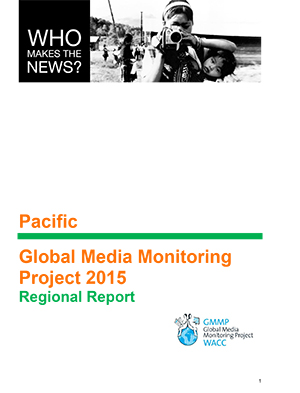
The latest Global Media Monitoring Project study reveals continuing severe disparity between representation of women and men in news media, indicating the portrayal of women in day-to-day journalism does not reflect their contribution to society. This is shared in the Pacific too, but Padre James Bhagwan also reports there is some good news.
ANALYSIS: Wednesday, December 2, was the International Day for the Abolition of Slavery. It marks the date of the adoption, by the General Assembly, of the United Nations Convention for the Suppression of the Traffic in Persons and of the Exploitation of the Prostitution of Others (resolution 317(IV) of 2 December 1949).
The focus of this day is on eradicating contemporary forms of slavery, such as trafficking in persons, sexual exploitation, the worst forms of child labour, forced marriage, and the forced recruitment of children for use in armed conflict.
The day also marks the beginning of the second week (eighth day) of the 16 Days of Activism Against Gender-Based Violence. One form of gender-based violence is structural violence. Structural violence refers to systematic ways in which social structures or social institutions may harm people by preventing them from meeting their basic needs.
Hunger and poverty are two prime examples of the physical and psychological harm that results from exploitive and unjust social, political and economic systems.
One form of structural violence is lack of progress toward equality of men and women in the news media.
This is according to the Global Media Monitoring Project (GMMP), a five-yearly study which has conducted research in 114 countries over 20 years. The study was undertaken on sampling the news of one particular day around the world — Wednesday March 25, 2015.
The study reveals continuing severe disparity between representation of women and men in news media, indicating the portrayal of women in day-to-day journalism does not reflect their contribution to society.
Portrayal of women
This year's study was GMMP's fifth and largest on the portrayal and representation of women in the news media. Findings indicate that, worldwide, women make up about 50 percent of the general population but only 24 percent of the persons heard, read about or seen in newspaper, television and radio news — exactly the same level found in the 2010 report.
Women's relative invisibility in traditional news media has also crossed over into digital news delivery platforms. Only 26 per cent of the people in internet news stories and media news "tweets" combined are women.
"The GMMP 2015 report examined the visibility, voice and mention of women and men in the news media and finds a sexism that has endured across decades and geographical boundaries, adapting to emerging media forms and thriving in all spaces in which news content is produced and shared," said Dr Sarah Macharia, GMMP global co-ordinator.
The report also found that, overall, women remain more than twice as likely as men to be portrayed as victims as they were a decade ago, at 16 and 8 per cent respectively.
Findings indicated that there is a global glass ceiling for female news reporters in newspaper bylines and newscast reports, with 37 per cent of stories reported by women, the same as a decade ago.
The GMMP is a project of the World Association for Christian Communication, with support from the United Nations Entity for Gender Equality and the Empowerment of Women.
 The Pacific has participated in the GMMP since 1995 when Fiji was the sole Pacific Island country to contribute towards the global study. In 2010 Papua New Guinea, Tonga, Australia and New Zealand joined enabling data to be collated across the wider Pacific region.
The Pacific has participated in the GMMP since 1995 when Fiji was the sole Pacific Island country to contribute towards the global study. In 2010 Papua New Guinea, Tonga, Australia and New Zealand joined enabling data to be collated across the wider Pacific region.
Highlights decade
The Pacific report from the GMMP highlights that from the last 10 years of data that women are still in the minority of news topics reflecting the gender inequality in the formal structures of decision-making and power of Pacific media outlets:
* Overall the presence of women in news items averaged at 25 percent (26 percent in traditional media and 24 per cent in online media. Women were more present in news topics on Science and Health (54 per cent women) in traditional media.
* However, in the remaining six topics, women were present far fewer times than men in both traditional and online media sources.
* The top three story topics which featured the most female news subjects were employment with 75 percent. Female subjects made up 67 percent of stories on celebrity, arts and media while sources on medicine, health, hygiene and safety topics featured 65 percent female news subjects. Women also made up 50 percent of stories featuring beauty contests, models, fashion and cosmetic surgery.
* Overall males were portrayed as victims more commonly than females (59 percent males and 41 percent females) across a wider range of situations. However females were more likely to be victimised in situations of non-domestic sexual violence, assault, rape (11 percent females and 4 per cent males).
* Out of the total number of news stories featured in newspapers in the region, stories that featured women were more likely to be photographed compared with news stories featuring male news subjects (34 percent of news stories featuring women were photographed and 19 percent of news stories featuring men were photographed).
* Overall 45 percent of reporters in the Pacific region were female. While there were 47 percent of reporters and presenters in print who were female and 46 percent of television reporters were female in radio 61 percent of announcers were female.
* Across the seven major news topic categories women were the central focus in only 16 percent of stories including 2 per cent in politics and governance, 11 percent in economy, 29 percent in science and health, 15 percent in Social and Legal, 20 percent in crime and violence, 23 percent in celebrity, arts and media and sports and 20 percent in other categories.
* Only five out of a total 359 news stories (1 per cent) raised issues of gender equality/inequality: Women politicians (20 per cent), other domestic policies (20 percent), employment (20 percent), human rights (20 percent) and legal system (20 percent).
* Overall, the majority of major news topics did not challenge gender stereotypes — an average of 1 percent of stories clearly challenged stereotypes.
* Female news sources were more likely to be found in stories reported by females (35 percent of all female sources were interviewed by female reporters while 26 percent of all female sources were interviewed by male reporters).
* Overall the gender of reporters made no difference in the proportion of stories that challenged stereotypes (97 percent of stories by female reporters did not challenge stereotypes while 98 percent of stories by male reporters did not challenge stereotypes).
More female presenters
The Pacific GMMP report does point out, however, that there has been a marked increase in the number of female reporters and presenters making the news from less than 30 percent in 2005 to nearly 50 percent across a wider scope of traditional media outlets.
"Although more women have made it into mainstream media as the makers of news there still has not been a wider structural change in media institutions therefore not only is the content of media reflective of society it is at the same time as affected by the gaps in gender mainstreaming as any other organisation, company or community in the Pacific."
Because of the recent rise in online media platforms Twitter and internet sources were also monitored in 2015. However there exists a digital divide between more developed countries such as Australia and New Zealand and small Pacific Island countries which accounts for the dominance in online data from the two former countries.
"Nevertheless online media is still largely dominated by male reporters and male news subjects. This highlights the growing need for newer forms of media sources to also be utilised as platforms for advancing gender equality."
Given these findings, the World Association for Christian Communication (WACC) and its GMMP coordinators are calling for an end to media sexism by 2020.
Dr Isabel Apawo Phiri, associate general secretary of the World Council of Churches (WCC) added the WCC's voice to that call. "Our prayer and hope is that, by the time we reach 2021, at the 11th WCC Assembly, we shall read a report that shows the news media has adopted a wider vision of equality and inclusion," said Phiri. "With the guidance of the Holy Spirit, together we can transform the media to make women more visible."
Report highlights
Highlights of the 2015 GMMP can be found at: http://cdn.agilitycms.com/who-makes-the-news/Imported/reports_2015/highlights/highlights_en.pdf while the full report can be found at: http://cdn.agilitycms.com/who-makes-the-news/Imported/reports_2015/global/gmmp_global_report_en.pdf
The Pacific report can be found at: http://cdn.agilitycms.com/who-makes-the-news/Imported/reports_2015/regional/Pacific_Islands.pdf
It is not only the news media that is challenged to widen its coverage of women and women's issues in the news. All of us must recognise the similar challenge to pay attention to who and what makes the news and open our own eyes to see and understand the issues affecting those who don't.
"Simplicity, serenity, spontaneity."
Reverend James Bhagwan is an ordained minister of the Methodist Church in Fiji and a citizen journalist. He is also the vice-president of the World Association of Christian Communication-Pacific Region. This article was first published in The Fiji Times. The opinions expressed in this article represent the personal views of the author. He can be contacted on padrejames@gmail.com
This work is licensed under a Creative Commons Attribution-NonCommercial 3.0 New Zealand Licence.




